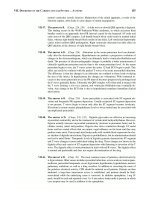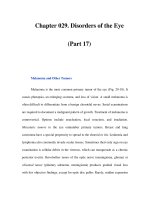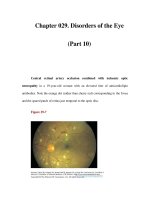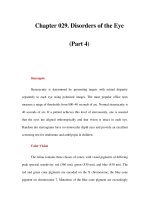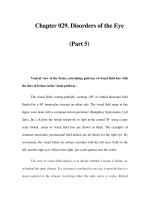Chapter 091. Benign and Malignant Diseases of the Prostate (Part 5) pot
Bạn đang xem bản rút gọn của tài liệu. Xem và tải ngay bản đầy đủ của tài liệu tại đây (43.81 KB, 5 trang )
Chapter 091. Benign and Malignant
Diseases of the Prostate
(Part 5)
TRUS is the imaging technique most frequently used to assess the primary
tumor, but its chief use is directing prostate biopsies, not staging. No TRUS
finding consistently indicates cancer with certainty. CT lacks sensitivity and
specificity to detect extraprostatic extension and is inferior to MRI in visualization
of lymph nodes. In general, MRI performed with an endorectal coil is superior to
CT to detect cancer in the prostate and to assess local disease extent. T1-weighted
images produce a high signal in the periprostatic fat, periprostatic venous plexus,
perivesicular tissues, lymph nodes, and bone marrow. T2-weighted images
demonstrate the internal architecture of the prostate and seminal vesicles. Most
cancers have a low signal, while the normal peripheral zone has a high signal,
although the technique lacks sensitivity and specificity. MRI is also useful for the
planning of surgery and radiation therapy.
Radionuclide bone scans are used to evaluate spread to osseous sites. This
test is sensitive but relatively nonspecific because areas of increased uptake are not
always related to metastatic disease. Healing fractures, arthritis, Paget's disease,
and other conditions will also cause abnormal uptake. True-positive bone scans are
rare if the PSA is <8 ng/mL and uncommon when the PSA is <10 ng/mL unless
the tumor is high-grade.
Prostate Cancer: Treatment
Clinically Localized Disease
Localized prostate cancers are those that appear to be nonmetastatic after
staging studies are performed. Patients with localized disease are managed by
radical surgery, radiation therapy, or active surveillance. Choice of therapy
requires the consideration of several factors: the presence of symptoms, the
probability that the untreated tumor will adversely affect the patient during his
lifetime and thus require treatment, and the probability that the tumor can be cured
by single-modality therapy directed at the prostate or requires both local and
systemic therapy to achieve cure. As most of the tumors detected are deemed
clinically significant, most men undergo treatment.
Data from the literature do not provide clear evidence for the superiority of
any one treatment. Comparison of outcomes of various forms of therapy is limited
by the lack of prospective trials, referral bias, and differences in the outcomes
used. The primary outcomes are cancer control and treatment-related morbidities.
Definitions of cancer control, however, vary by modality. Often, PSA relapse–free
survival is used because an effect on metastatic progression or survival may not be
apparent for years. After radical surgery to remove all prostate tissue, PSA should
become undetectable in the blood within 4 weeks, based on the PSA half-life in
the blood of 3 days. If PSA remains detectable, the patient is considered to have
persistent disease. After radiation therapy, in contrast, PSA does not become
undetectable because the remaining nonmalignant elements of the gland continue
to produce PSA even if all cancer cells have been eliminated. Similarly, cancer
control is not well-defined for a patient managed by active surveillance because
PSA levels will continue to rise in the absence of therapy. Other outcomes are
time to objective progression (local or systemic) and cancer-specific and overall
survival; however, these outcomes may take years to assess.
The more advanced the disease, the lower the probability of local control
and the higher the probability of systemic relapse. More important is that within
the categories of T1, T2, and T3 disease are tumors with a range of prognoses.
Some T3 tumors are curable with therapy directed solely at the prostate, and some
T1 lesions have a high probability of systemic relapse that requires the integration
of local and systemic therapy to achieve cure. For T1c tumors in particular, stage
alone is inadequate to predict outcome and select treatment; other factors must be
considered. Many groups have developed prognostic models that use a
combination of the initial T stage, Gleason score, and baseline PSA. Some use
discrete cut points (PSA <10 or ≥10; Gleason score of ≤6, 7, or ≥8); others are
nomograms that use PSA and Gleason score as continuous variables. These
algorithms can be used to predict disease extent (organ-confined vs. non-organ-
confined, node-negative or -positive) and the probability of success of treatment
using a PSA-based definition specific to the local therapy under consideration.
Specific nomograms have been developed for radical prostatectomy, external
beam radiation therapy, and brachytherapy (seed implantation). These are being
refined continually to incorporate other clinical parameters and biologic
determinants. Surgical technique, radiation therapy delivery, and criteria for active
surveillance continue to be refined and improved; the year of treatment affects
outcomes independent of other factors. The improvements make treatment
decisions a dynamic process.
The frequency of adverse events for the different treatment modalities
varies with the modality used and the experience of the treating team. For
example, following radical prostatectomy, incontinence rates range from 2 to 47%
and impotence rates range from 25 to 89%. Part of the variability relates to how
the complication is defined and whether the patient or physician is reporting the
event. The time of the assessment is also important. After surgery, impotence is
immediate but may reverse over time, while with radiation therapy impotence is
not immediate but may develop over time. Of greatest concern to patients are the
effects on continence, sexual potency, and bowel function.
